Bright orange flesh gives a beautiful color and silky texture to this kabocha squash soup, while coconut milk provides extra creaminess and flavor. With apple cider, green apples, and ginger, it’s a naturally sweet vegan recipe that’s comforting and nutritious.

Even though your mind may be focused on mashed potatoes, turkey, and pie for Thanksgiving in a couple of a weeks, I’m thinking about soups at the moment! Being the vegetable lover that I am, I love to use soup season as an opportunity to try some of the more unique vegetables that are in currently in season. For example, I recently made a soup with swede (aka rutabaga) topped with crispy fried onions (yum).
This recipe uses kabocha squash, also known as Japanese pumpkin. Kabocha squash is slightly sweeter than butternut or acorn squash and has a smoother, creamier texture. It has a flattened spherical shape and usually has dark green skin, but some varieties have grey-blue skin. Blue kabocha squash is also known as Blue Kuri.
When cooked, kabocha squash develops a velvety mouthfeel that can transform a dish into a smooth, decadent meal. I paired it with coconut milk in this recipe to really lean into the creaminess. I also added apple cider and green apples for a little sweetness and ginger for a kick.
You can find kabocha squash in most areas during the fall and winter. Check out your local farmers markets or grocery stores to purchase one if you are interested in making this kabocha squash soup recipe.
Jump to:
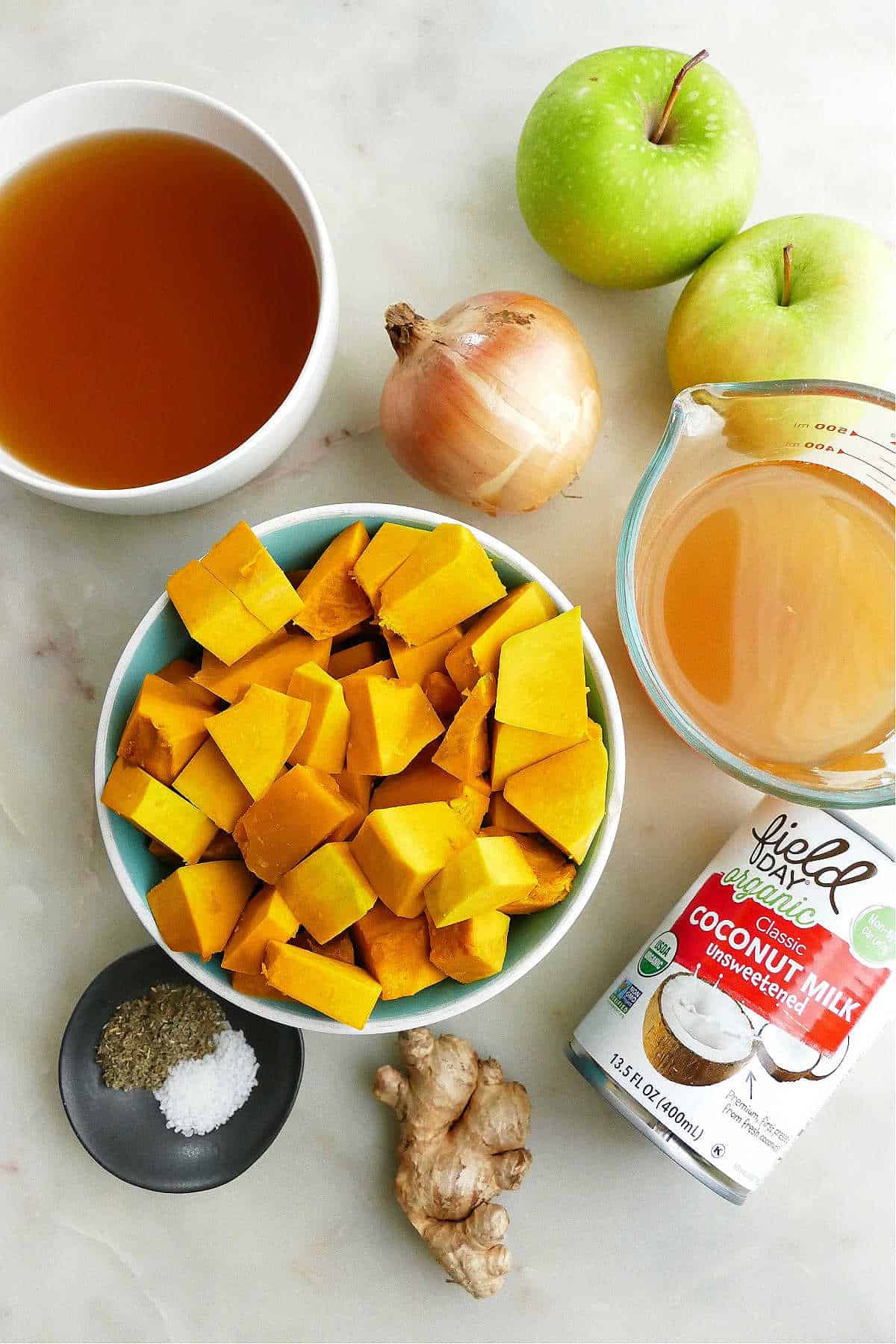
Ingredients and Substitutions
- Kabocha squash: This is a pretty key ingredient. You can substitute other types of winter squash, but you won’t get the same creaminess that kabocha provides.
- Coconut milk: Use full-fat, unsweetened coconut milk — the kind you find in a can and not in a carton.
- Onion: I used a yellow onion, but you can pretty much use any variety.
- Granny Smith apples: Green apples provide the best flavor for this soup, since they are tart. It’s possible to make kabocha squash soup with other types of apples, but the flavor may be slightly different.
- Apple cider: This is a really lovely addition. Don’t skip it!
- Ginger: Use chopped fresh ginger. If you don’t have that on hand, use 2 teaspoons of dried ginger in place of the 2 tablespoons fresh.
- Dried sage: You can substitute dried thyme for the sage if needed.
- Vegetable stock: You can also use broth.
Instructions
The full recipe card, including ingredient quantities and all of the steps for making kabocha squash soup, can be found at the end of the post. Here’s a preview of the easy steps.

Cut the kabocha squash in half lengthwise, then cut into wedges. Remove the seeds from the wedges, and peel the skin. Then, cut into cubes.
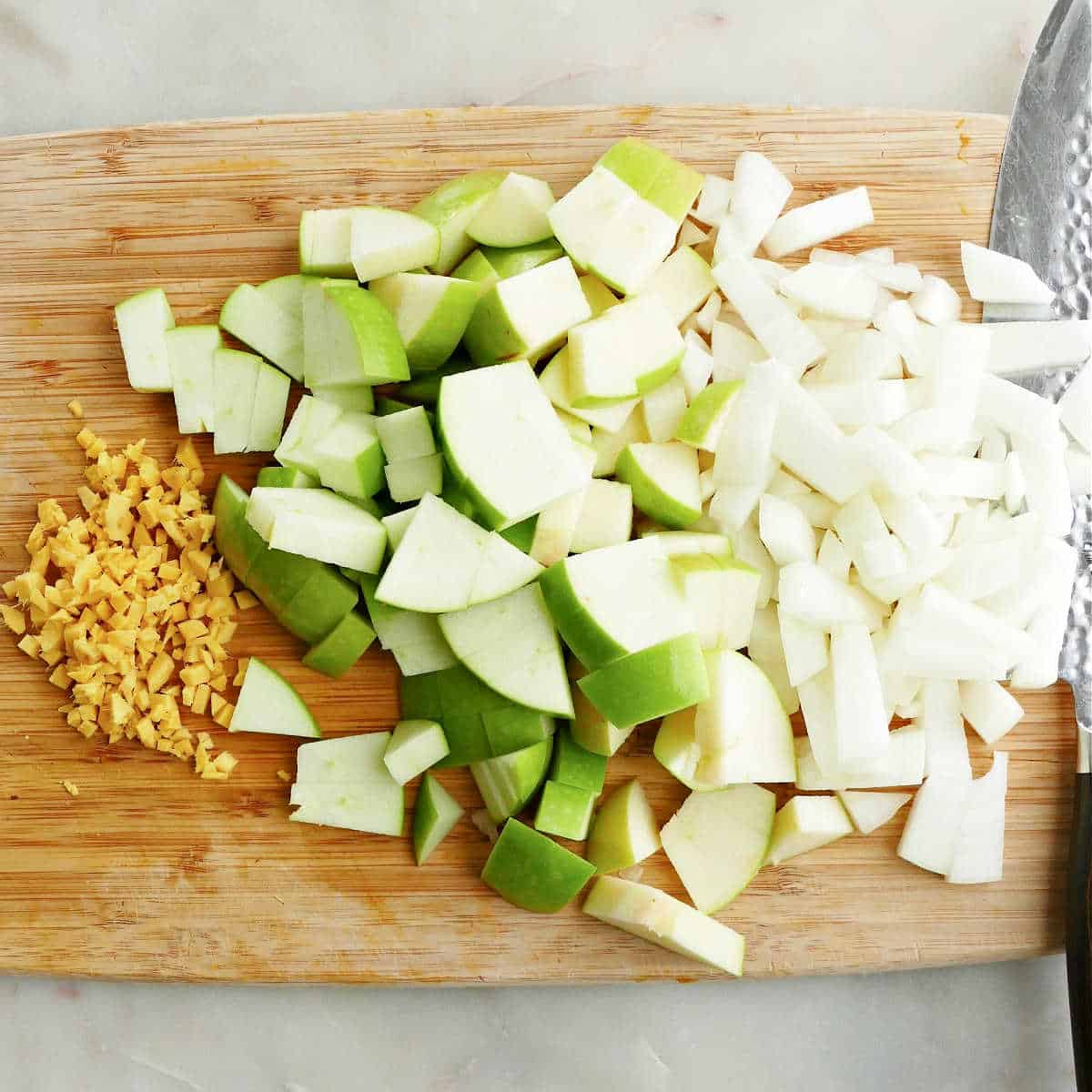
Prep the other ingredients. Dice the onion, apples, and ginger.
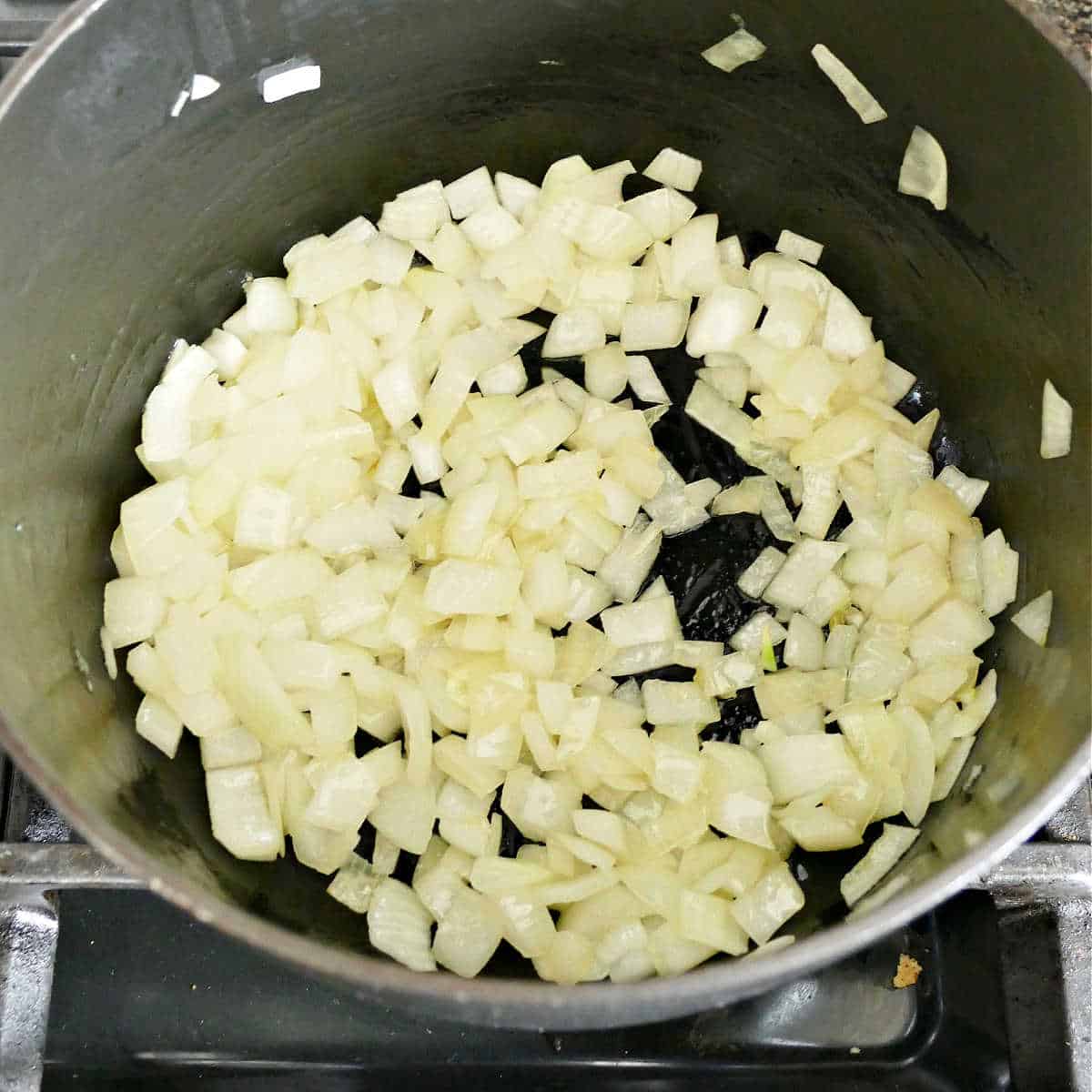
Warm olive oil in a soup pot over medium heat. Add the onion and cook until softened.

Add the squash, apples, ginger, salt, and dried sage to the pot.
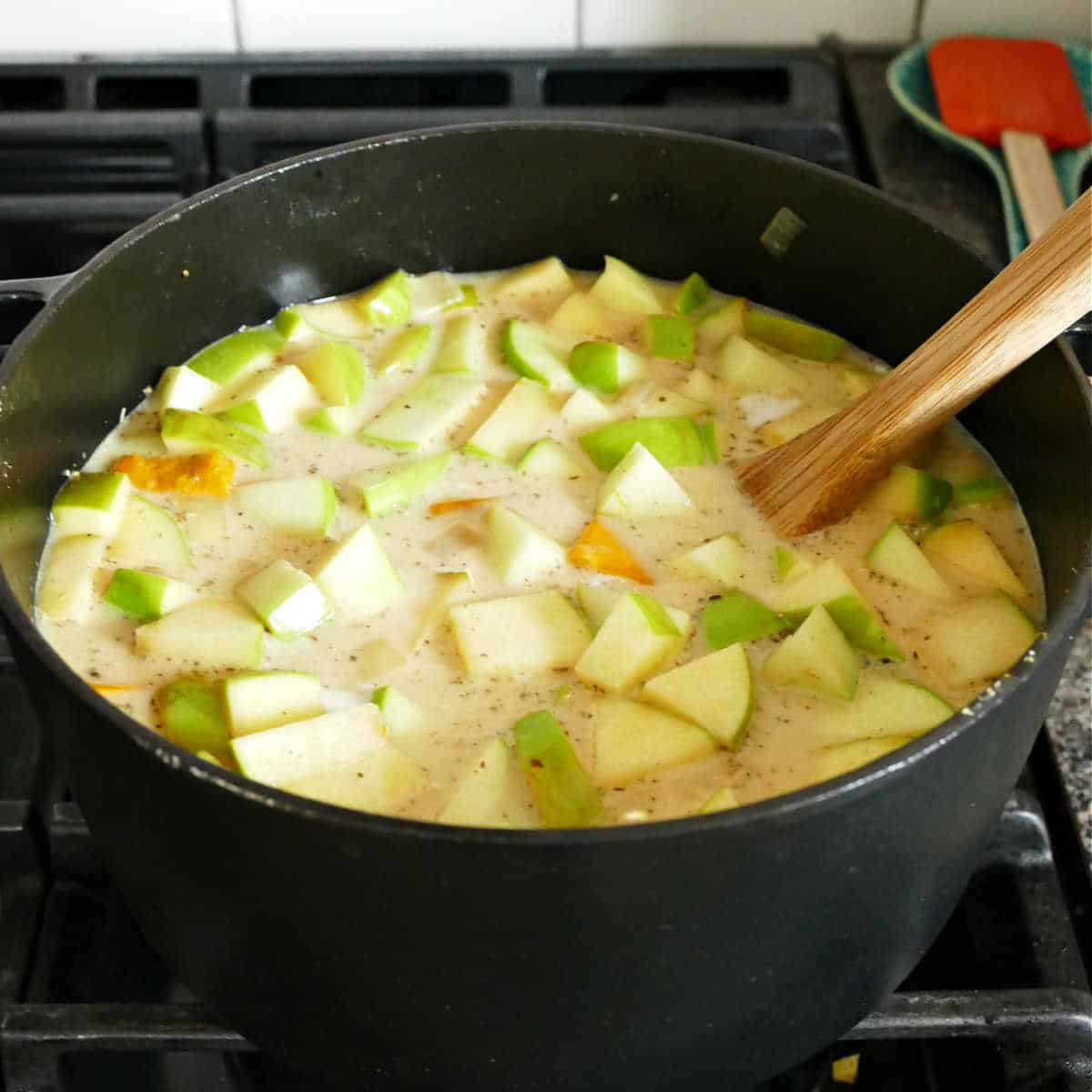
Pour in the vegetable stock, apple cider, and coconut milk. Increase heat to bring to a boil, then reduce heat, cover, and let simmer for about 15 minutes.
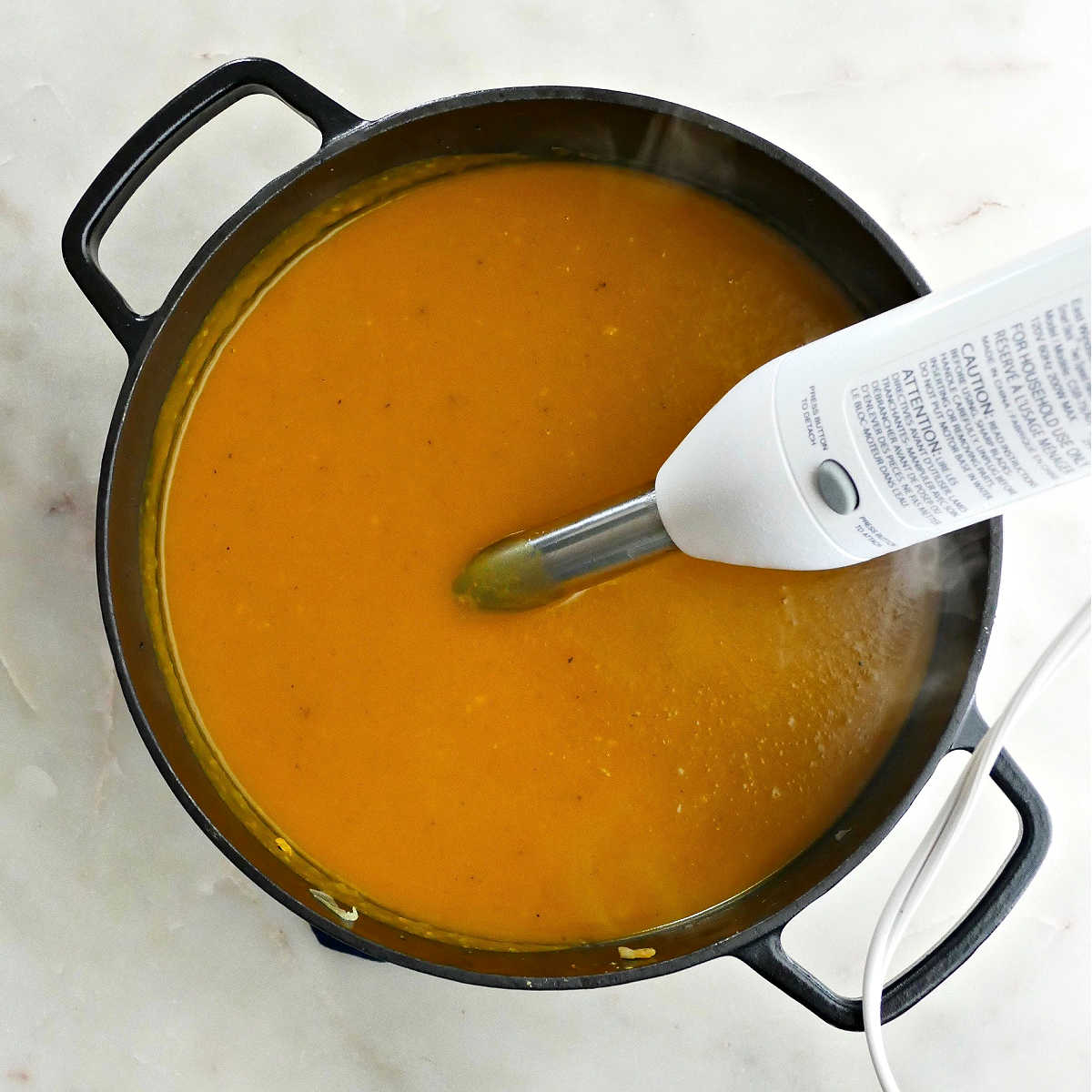
Remove the soup from heat, and use an immersion blender to blend the soup right in the pot. Here is the handheld immersion blender that I use. You can also use an upright blender to puree the soup in batches.

Storage and Reheating
Kabocha squash soup keeps well in the refrigerator and freezes beautifully. Store in an airtight container in the fridge for up to a week. Reheat in a pot or saucepan over medium-low heat, stirring frequently, until warmed through.
To freeze this soup, let it cool completely then transfer to freezer-safe containers. Leave about an inch of headspace in case the soup expands while freezing. Reheat from frozen or thawed in a pot or saucepan. Just remember to keep an eye and stir frequently to prevent scorching.

FAQs
If needed, soften kabocha squash in the microwave first. Cut a few slits in the skin then microwave for about 4 minutes. Carefully remove the squash from the microwave and slice in half from stem to bottom. Turn each half flesh side down and cut into wedges. Remove the seeds from each wedge with a spoon. Peel the skin with a paring knife or swivel peeler. Finally, cut each wedge into cubes. See my YouTube video on how to cut kabocha for more tips.
Even though the skin is technically edible, it’s best to peel kabocha squash. This is especially true when making soup, since you want to have a smooth soup without any bits of skin.
Kabocha squash is loaded with beneficial nutrients and fiber. Like most foods with bright orange flesh, this squash has tons of beta-carotene, a carotenoid that converts to vitamin A in the body. Eating foods with these nutrients can support vision and immune health.
More Squash Recipes
I’d love to hear how you like this recipe! Rate/review using the stars on the recipe card or in the comments, and follow the Veg World on YouTube, Instagram, Facebook, and Pinterest. Looking for something totally different? Browse the recipe library.
📖 Recipe

Kabocha Squash Soup with Coconut Milk and Apple Cider
Equipment
- Immersion blender (can also use an upright blender)
Ingredients
- 1 tablespoon extra virgin olive oil
- 1 yellow onion - diced
- 1 kabocha squash - peeled, deseeded, and diced into 1" cubes; approximately 6 cups
- 2 Granny Smith apples - cored and diced
- 2 tablespoons chopped fresh ginger
- 1 teaspoon dried sage
- ½ teaspoon salt
- 1 14.5-ounce can unsweetened coconut milk
- 2 cups vegetable stock
- 1.5 cups apple cider - (NOT apple cider vinegar)
Instructions
- In a large pot, warm the olive oil over medium heat. Add the onion and sauté for approximately 5 minutes before adding the squash, apples, ginger, sage, and salt.
- Pour in the coconut milk, vegetable stock, and apple cider. Bring to a boil, then cover and reduce heat to maintain a simmer. Let the soup cook for 15 to 20 minutes, or until the squash is tender when touched with a fork.
- Remove the pot from heat and use an immersion blender to blend the soup until smooth. Alternatively, you can use a regular blender and puree the soup in batches. Just remember to leave the lid cracked to allow steam to escape and be careful not to overfill the blender.
- Ladle the soup into bowls. If desired, garnish with fresh herbs (such as sage or thyme leaves) and a drizzle of coconut milk if you have it. Enjoy!
- Leave a rating or review by tapping the stars on this recipe card (above) or in the comments section (at the end of the post)!
Notes
Nutrition
Isn’t she gorgeous?! – Lizzie
This post was originally published in November 2018. It was updated with new photos and tips in November 2022.








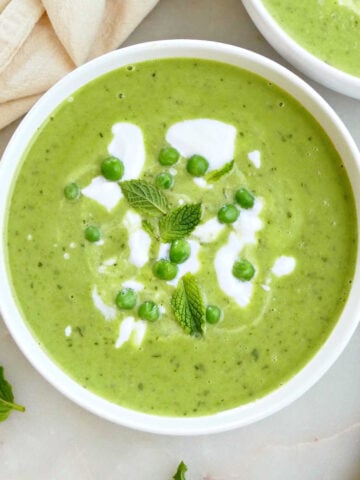



chandra
Can you use low fat coconut milk in this soup? Thanks!
Lizzie Streit, MS, RDN
Hi Chandra, yes you can!
Danielle Kane
What a delicious soup – just like the Fennel and Leek Soup with Potatoes, it is full of flavor and easy to make! I like the coconut milk – feels good to my tummy!
Lizzie Streit, MS, RDN
Hi Danielle, I’m so glad to hear you enjoyed the soup! Thank you so much for leaving a 5-star review!
Danielle Kane
The review is duly earned. I’m making it again for company 🙂